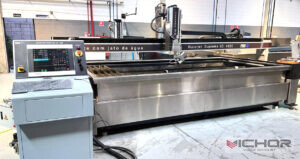
Water Cutting Machine: How It Works, Applications, and Key Insights for Modern Industries
In today’s fast-paced industrial landscape, precision and efficiency are paramount. One technology that has revolutionized manufacturing and fabrication processes is the water cutting machine. Also known as waterjet cutting, this method uses high-pressure water streams to cut through a variety of materials with incredible accuracy. Whether you’re in aerospace, automotive, or art design, understanding how a water cutting machine operates and its benefits can transform your operations. In this article, we’ll dive deep into the workings, applications, types, and more, with insights from VICHOR, a trusted name in the international waterjet cutting industry. By the end, you’ll have a clear picture of why this tool is indispensable and how it can serve your needs.
How a Water Cutting Machine Operates
A water cutting machine functions by harnessing the power of high-pressure water to slice through materials. At its core, the system includes a high-pressure pump that pressurizes water to levels exceeding 60,000 psi. This pressurized water is then forced through a small nozzle, creating a focused stream that can cut with precision. In many cases, an abrasive material, such as garnet, is added to the water stream to enhance cutting capability for harder substances like metals or ceramics. This combination allows the water cutting machine to handle everything from soft foams to tough alloys without generating heat, which prevents material distortion or damage. The process is controlled by CNC (Computer Numerical Control) systems, ensuring repeatability and accuracy in complex designs. VICHOR’s advanced models, for instance, integrate smart controls for seamless operation, making them a top choice for industries demanding high-quality cuts.
Applications of Water Cutting Machines Across Industries
The versatility of a water cutting machine makes it suitable for a wide range of applications. In the aerospace sector, it’s used to cut lightweight composites and titanium components with minimal waste. Automotive manufacturers rely on waterjet cutting for shaping body parts and interior elements, thanks to its ability to work with diverse materials without altering their properties. Construction and architecture benefit from precise stone and tile cutting for custom designs, while the food industry uses pure water jets for hygienic slicing of products. Even art and design professionals employ water cutting machines to create intricate sculptures from glass or metal. At VICHOR, we’ve seen our machines adopted in these fields and more, offering solutions that boost productivity and creativity. The adaptability of a water cutting machine means it can replace traditional methods like laser or plasma cutting in scenarios where heat sensitivity or material variety is a concern.
Key Features and Functions of Modern Water Cutting Systems
When investing in a water cutting machine, it’s essential to consider its core features. Precision is a standout trait, with tolerances as tight as 0.1 mm achievable in many models. This is coupled with high speed, enabling rapid production without sacrificing quality. Another critical function is the ability to cut a broad spectrum of materials—from plastics and rubber to hardened steel and stone—using the same system. Modern water cutting machines often include user-friendly interfaces, automatic abrasive feed systems, and safety mechanisms like enclosed cutting areas to protect operators. VICHOR’s offerings, for example, emphasize energy efficiency and low maintenance, reducing long-term operational costs. Additionally, these machines support 2D and 3D cutting, allowing for complex geometries that other tools might struggle with. By focusing on these features, businesses can maximize their return on investment and streamline their workflows.
Types of Water Cutting Machines Available Today
Water cutting machines come in several types to suit different needs. The primary categories include pure waterjet systems and abrasive waterjet systems. Pure waterjet machines use only high-pressure water and are ideal for softer materials like foam, rubber, or food products. In contrast, abrasive waterjet machines mix abrasives into the water stream, making them suitable for cutting metals, ceramics, and composites. Beyond this, there are distinctions based on configuration, such as gantry-style machines for large-scale industrial use or portable units for on-site jobs. Some advanced models from brands like VICHOR offer 5-axis cutting capabilities for multi-dimensional projects. Understanding these types helps in selecting the right water cutting machine for your specific applications, whether you’re in heavy manufacturing or custom fabrication.
Pricing and Cost Considerations for Water Cutting Equipment
The cost of a water cutting machine can vary widely based on factors like size, capabilities, and brand. Entry-level systems might start around $50,000, while high-end industrial models from companies like VICHOR can exceed $200,000. It’s not just the initial purchase price to consider; operating costs include abrasive materials, water consumption, pump maintenance, and energy usage. On average, running a water cutting machine might add $10 to $30 per hour in consumables, but this is often offset by reduced material waste and higher efficiency. Leasing or financing options are available for smaller businesses, and VICHOR provides transparent pricing models to help clients budget effectively. When evaluating costs, think about the long-term benefits—such as faster turnaround times and versatility—that make a water cutting machine a worthwhile investment.
Service and Support for Water Cutting Systems
Reliable service is crucial for maintaining the performance of a water cutting machine. Regular maintenance tasks include nozzle replacement, pump checks, and software updates to ensure optimal operation. Many providers, including VICHOR, offer comprehensive service packages that cover training, technical support, and spare parts delivery. This minimizes downtime and extends the machine’s lifespan. For international clients, VICHOR has a global network of service centers, providing prompt assistance whenever needed. Additionally, remote diagnostics and online resources help users troubleshoot common issues quickly. Investing in a water cutting machine with strong service backing means you can focus on production without worrying about unexpected breakdowns.

Custom Solutions with VICHOR Water Cutting Machines
Every business has unique needs, and that’s where customized solutions come into play. VICHOR specializes in tailoring water cutting machines to specific industrial requirements, whether it’s integrating automation for high-volume production or designing compact units for limited spaces. Our team works closely with clients to assess their material types, output goals, and budget, delivering systems that enhance efficiency. For example, we’ve developed waterjet cutting solutions for niche applications like underwater cutting to reduce noise and splash. By partnering with VICHOR, you gain access to innovative technologies and expert advice, ensuring your water cutting machine aligns perfectly with your operational strategy.
Frequently Asked Questions About Water Cutting Machines
Q1: What is the main advantage of using a water cutting machine over other cutting methods?
A1: The primary advantage of a water cutting machine is its ability to cut without generating heat, which prevents material damage, warping, or hazardous fumes. This makes it ideal for heat-sensitive materials and allows for precise, clean cuts across a wide range of substances.
Q2: Can a water cutting machine handle thick materials like metal?
A2: Yes, with the addition of abrasives, a water cutting machine can effectively cut thick metals, including steel and titanium, up to several inches thick. The process remains accurate and does not compromise the material’s integrity.
Q3: How much maintenance does a water cutting machine require?
A3: Regular maintenance for a water cutting machine typically involves checking the high-pressure pump, replacing nozzles and seals, and monitoring abrasive levels. With proper care, these machines can last for decades, and brands like VICHOR offer service plans to simplify upkeep.
Q4: Is a water cutting machine environmentally friendly?
A4: Generally, yes. Waterjet cutting uses water and natural abrasives, which are recyclable in many systems. It produces minimal waste compared to other methods, and VICHOR designs energy-efficient models to reduce environmental impact.
Q5: What factors should I consider when choosing a water cutting machine?
A5: Key factors include the types of materials you’ll cut, required precision, production volume, and budget. Also, consider the machine’s service support and customization options. Consulting with experts like those at VICHOR can help you select the best water cutting machine for your needs.
In conclusion, a water cutting machine is a powerful, versatile tool that can elevate your manufacturing or creative projects. From its efficient operation to broad applications and customizable solutions, it offers numerous benefits for modern industries. If you’re looking to invest in this technology, VICHOR stands out as a reliable partner with a global reputation for quality and innovation. Explore how a water cutting machine can transform your workflow and drive success in your field.
continue reading
Related Posts
- 1350 words6.8 min read



